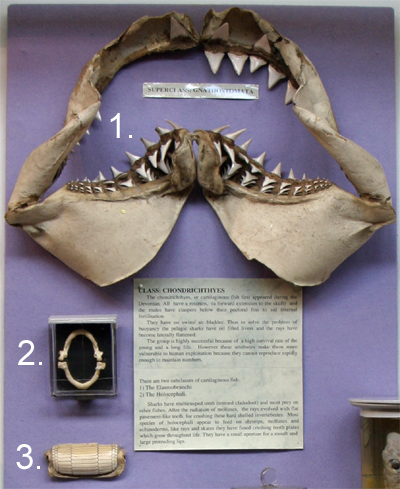
JAWS AND TEETH OF CARTILAGINOUS FISH
Sharks have multi-cusped teeth and most prey on fishes. Their teeth are continually shed and replaced. Some shark may loose 20,000 – 30,000 teeth in a life time. The front row of teeth is the biting row, behind are row on row of teeth ready to pop up as outer teeth are lost. Their jaws are loosely attached to the cranium allowing the jaws to gape very widely.
Skates and rays have flat, pavement-like teeth for crushing hard shelled, benthic (bottom-living) invertebrates. They became common in the Carboniferous period (290 - 360 mya) when the molluscs and cephalopods upon which they feed radiated into many different kinds.
Chimaeras have fused crushing pavement-like tooth plates which grow throughout their lives. They use these to feed on shrimps, molluscs and echinoderms. Their mouths have small apertures and large protruding lips.

1. Jaws of an identified shark showing several rows of teeth and wide gape. The teeth at the top are 4.5 cm high and the jaws are 60 cm across at the widest part.
2. Jaws and pavement teeth of a skate (Raja sp).
3. Pavement teeth of a skate (Raja sp).
4. A single tooth of a fossil shark. The height of this tooth (14 cm) in comparison to that (4.5 cm) of the teeth in the jaws from a modern shark above suggests that its original owner must have been truly monstrous!







